__We know, the idea of making a career change is a scary one. What path should you choose? Where should you get your education? How do you make the final leap? __
Today, jobs in technology are usually the safest bet, with positions that are in-demand, always evolving, and likely to last as long term career paths. But with 80,100 new tech jobs created in Toronto in the last five years, and 54,000 more jobs than graduates in 2018, we already know that It’s Still a Great Time to Break into Tech. The real question is - how do you do it?
Ready to kickstart your tech career?
At Juno, we're the experts in helping people with non-technical backgrounds build rewarding careers as web developers. Check out Juno’s free guide to Kickstarting Your Tech Career!
Download Free Guide to Kickstarting Your Tech Career
What is a Web Developer?
The first step to becoming a web developer is understanding what a web developer does. Though TV shows and movies might have you thinking that developers spend their days wearing hoodies typing away in dark basements, that’s not the case.
In reality, web developers are responsible for the creation of every website you interact with on a daily basis. From Googling to reading reviews to online shopping, everything you do on the web was built by a developer.
Simply put, there are two kinds of web developers - those who work on the front-end and those who work on the back-end. Front-end developers build and style everything you see on a website using languages like HTML, CSS, and JavaScript. Back-end developers use languages like Ruby, Python, and Node to make advanced websites function behind-the-scenes.
At Juno, we focus mainly on Front-End Web Development. In most cases, a front-end developer will take a mockup of a website created by a designer and use code to turn it into a functioning site. Using a variety of languages, like HTML to layout the content, CSS to style it, and JavaScript to add more functionality, front-end developers take a basic design and turn it into a live website that you can use and interact with. Download our Coding 101 Package to learn more about the kind of work that Front-End Web Developers do and the languages they use.
Those making a career change into Web Development come from a variety of backgrounds and experiences. From baristas, to accountants, to teachers, to sales-people, anyone looking to make a career change and willing to put in the effort to learn can become a developer. At Juno, we’re the experts in helping absolute beginners make a career change, fast, and we’ve helped over 700 people do just that.
How much do Web Developers make?
According to CBRE’s 2019 Scoring Tech Talent Report, ‘software developers and programmers’ have an average salary of $82,805 in Toronto, with numbers varying based on experience and skill level.
At Juno, we run a Web Development Immersive Bootcamp that teaches students to become front-end developers in just nine weeks. In their first job after Bootcamp, our 2018 students had an average salary of $54,449 CAD. You can download our most recent Student Outcomes Report to learn more about our students’ success like how long it took them to find a job and more.
How to Become a Web Developer
Step 1 - Choose Your Path
If you search for web development jobs online, you’ll see many different titles. UX Developer, Front-End Developer, Back-End Developer, Full-Stack Developer, Application Developer, and Software Developer are just a few of the options. At Juno we teach all of our Bootcamp students the skills needed to become front-end developers, but in their first jobs after graduation they too have a myriad of different titles.
So, the first step in becoming a developer is deciding what kind of developer you want to be. The only problem is that it can be hard to understand the differences and which would be right for you, especially without knowing any code first.
For this reason, starting your learning journey in front-end can be the most rewarding because you can immediately see the results of your work. Coding in languages like HTML and CSS shows you what you’re creating as you do it. In seconds, your page can go from white to blue or any colour of your choosing. In back-end development, you are often building complex functionality that takes longer to materialize.
Additionally, if you learn your front-end skills and want to transition into back-end or a different field, it’s easier to do so with front-end experience.
Step 2 - Learn to Code
Once you’ve decided on what kind of development you want to learn first, the next step is, well, learning it! Today there are many different options, from traditional universities, to career colleges, to Bootcamps, to online courses. When deciding which one is right for you, it’s important to understand the pros and cons of each.
Traditional Universities
If you’re considering learning to code as your first learning path out of highschool, enrolling in a traditional university for a four-year program may be an option. You’ll graduate with a traditional education and degree, and a theoretical understanding of different coding languages.
However, if you’re looking to make a career change after already investing in a university/college degree, the idea of going back to school for four years is likely very daunting. Luckily, there are many learning options that don’t require as big of a time commitment or financial investment.
Career Colleges & Bootcamps
Career Colleges and Bootcamps have become very popular in recent years as an alternative to traditional education. For many students who are looking to make a career change, Bootcamps and Career Colleges are a great option that require less of a financial investment and time commitment. These types of schools also typically offer a more hands-on learning model, giving students an education focused on real-world skills they can apply in their new careers.
However, as this learning model becomes popular and more Career Colleges and Bootcamps start popping up all over the globe, it’s important to do your research and make sure you're investing in the right one. At Juno, we’ve been perfecting and updating our curriculum for years and offer personalized career coaching to ensure that every one of our Bootcamp graduates gets a job after graduation.
But, this can’t be said for all Bootcamps. Reading online reviews and understanding what kind of skills you'll learn and what support you’ll receive after graduation is vital to being satisfied with your education.
Online Learning
As coding becomes more popular, there are a ton of ways to learn to code online - some of them are even free. This is a great way to try your hand at coding for the first time in a risk-free environment before deciding if you want to pursue that career path.
Learning independently and self-teaching strictly through online resources can be challenging for some people. You may not know where to start, where to go when you need help answering a question, or how to stay disciplined to stick with the lessons. You also may not know if some of the resources you're referring to are out of date with current best practices.
This is why Live Online courses such as ours are a great option for those looking to accelerate their learning alongside a supportive community! You'll get the same personalized mentorship and hands-on experience as you would with in-person learning.
Step 3 - Build a Portfolio
After you’ve learned the skills you need to become a developer, the next step is building a portfolio to showcase those skills. As a developer, your portfolio should be in the form of an online website that is well coded and nicely designed. Your portfolio should be a simple way for potential employers to get a sense of who you are and what you can do. You should have information about yourself, the skills and languages you know, a way for people to contact you, and most importantly - a selection of projects you’ve built using your new skills. When it comes to development, potential employers are looking to see your skills in action. It’s not enough to tell them what you know, you have to show them as well.
Luckily in programs like Juno’s Web Development Bootcamp, our students build portfolio-worthy projects throughout the program, and later build a website to showcase them. Through design critiques, development support, and personalized feedback we make sure each student leaves our program with a portfolio that will impress potential employers. See some of our grads and their portfolios here.

Step 4 - Apply for Jobs & Complete Tech Tests
The final step in becoming a web developer is applying for jobs! There are many sites like Indeed and GlassDoor that offer listings that are filterable by the kind of job you want, where you want to work, and even the salary you’d like to make. Sending out job applications on a regular basis with professional resumes, tailored cover letters, and personalized follow ups is a key part of finding success. That’s why Juno's proven job-seeking process is also a big part of the training we offer our students towards the end of Bootcamp, and the support we offer them after graduation.
The important thing to note is that the interview process for development roles is different than the average interview process. Developers are often asked to complete a tech test to prove their coding skills. When it comes to development, a degree or an education on paper isn’t enough. You must be able to prove you are proficient in the skills you’ve listed on your resume. Having hands-on knowledge of coding languages is vital to completing tech challenges and finding success.
Ultimately, becoming a web developer isn’t a complicated process, even if you’re starting from scratch and know nothing about code.
As long as you know how to open a zip file and are comfortable using keyboard shortcuts, you have the technical skills needed to get started. All you need to do is decide what you want and move towards it. If you’re willing to put in the work and invest in yourself and your future, a long term and lucrative career as a developer is possible.
At Juno, we’re the experts in helping beginners make a career change, fast. From our Web Development course to our Web Development Immersive Bootcamp, our proven process works. Students start by learning the absolute basics and graduate with the skills, projects, and support they need to land a job as a front-end developer in a booming industry, in as little as six months.
If you’re ready to find out more about making a career change into Web Development, schedule a free call with one of our Student Success Consultants now:


